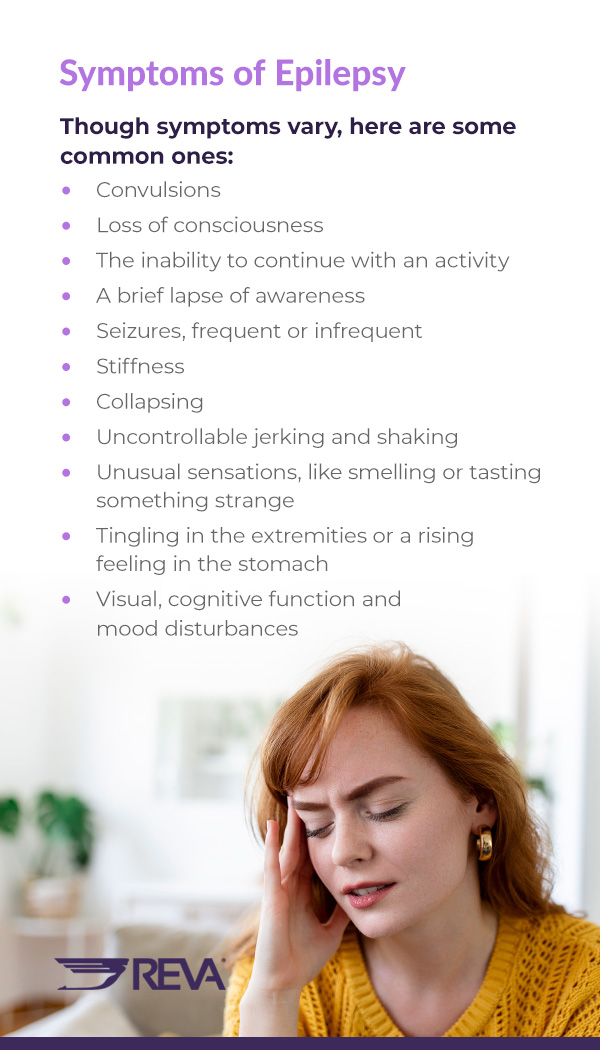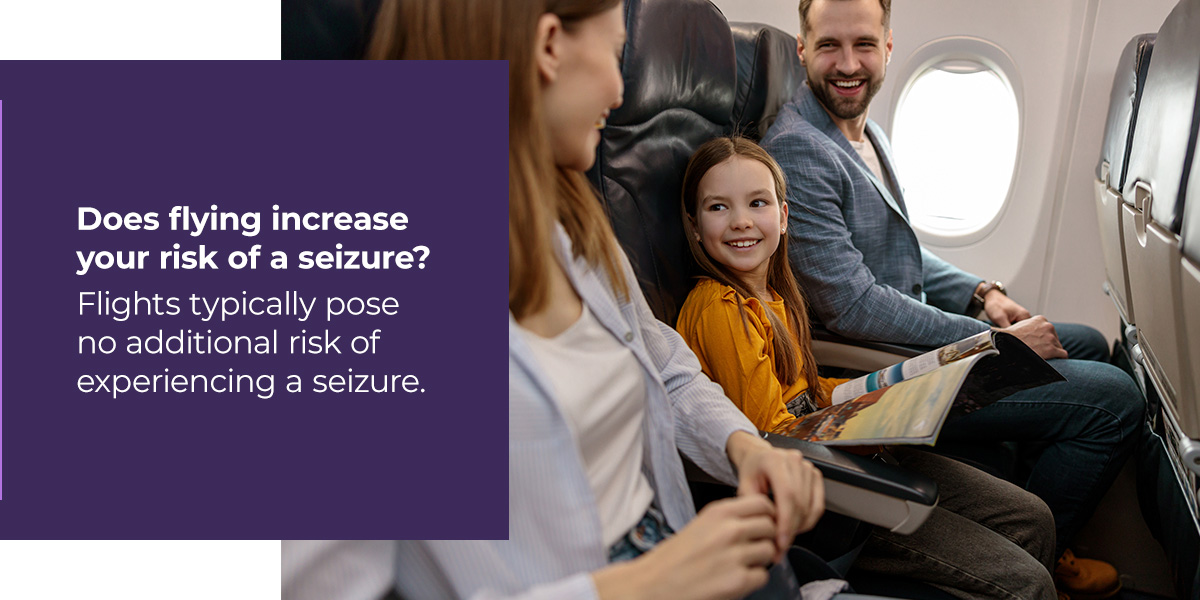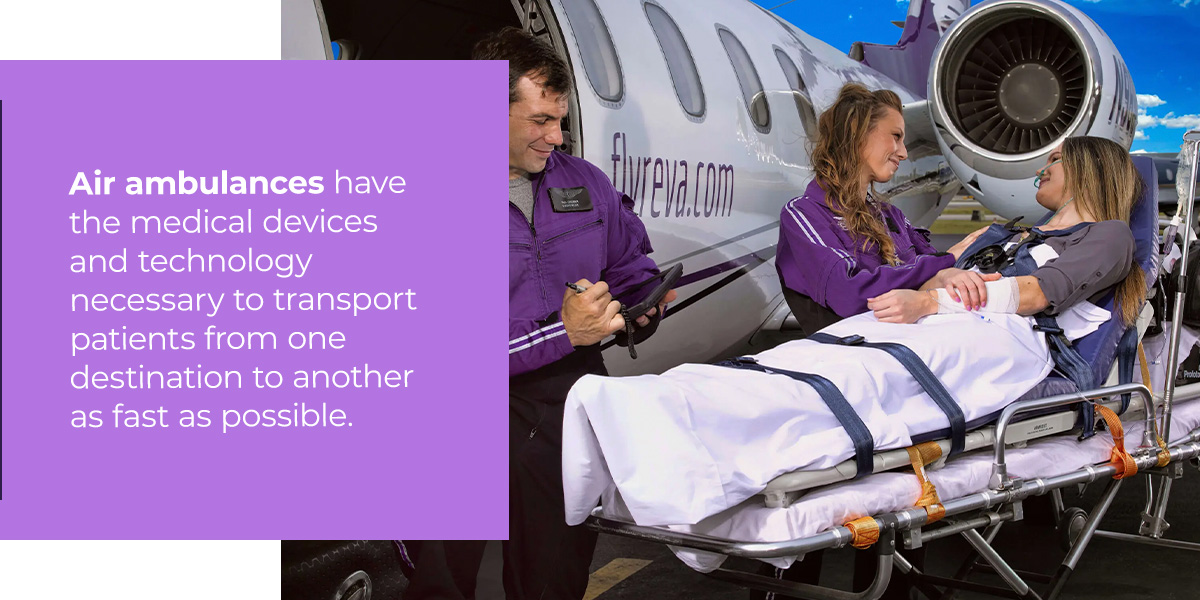Can You Fly With Epilepsy?
While you should not fly with some medical conditions, you can fly with epilepsy — but it is crucial to plan and take precautions to ensure the safety of yourself and others.
When it comes to epilepsy, being at a high altitude for a long time may increase your risk of seizures. The effect of high altitude on individuals with epilepsy may relate to the severity of their condition. Therefore, if you have uncontrollable seizures, you might want to avoid flying long distances by choosing connecting flights or layovers.
No matter what, a person with seizures can fly safely, but you may feel safer with a medical escort. Below, learn more about flying with epilepsy and how you can do so comfortably to enjoy a successful trip.
All About Epilepsy
Epilepsy is a chronic neurological condition where clusters of nerve cells, or neurons, transmit abnormal signals and cause seizures. Typically, neurons create chemical and electrical signals instructing other glands, muscles and neurons to produce actions, thoughts and feelings.
During a seizure, countless neurons transmit signals simultaneously. They convey the signals often — 500 times per second or less — which is faster than average. Experiencing such a large quantity of simultaneous electrical signals causes involuntary behaviors, emotions, movements and sensations. Some people experience a loss of awareness because of this temporary disturbance of regular nerve cell activity.
About 5 million people internationally are diagnosed with epilepsy each year, and an estimated 2.3 million adults and more than 450,000 children and adolescents in the United States live with epilepsy.
Symptoms of Epilepsy
The symptoms of epilepsy differ based on where the abnormality starts in the brain and how far it spreads. Because of the seizures, people with epilepsy tend to experience more fractures, breaks, bruises and psychological conditions like depression and anxiety. Though symptoms vary, here are some common ones:
- Convulsions
- Loss of consciousness
- The inability to continue with an activity
- A brief lapse of awareness
- Seizures, frequent or infrequent
- Stiffness
- Collapsing
- Uncontrollable jerking and shaking
- Unusual sensations, like smelling or tasting something strange
- Tingling in the extremities or a rising feeling in the stomach
- Visual, cognitive function and mood disturbances
Types of Epilepsy
There are hundreds of types of epilepsy syndromes. Medical professionals characterize these syndromes by their symptoms or origin in the brain. Here are some epilepsy syndromes:
- Absence: Individuals with this epilepsy experience repeated seizures that cause momentary lapses of consciousness. These seizures are common in families, so a genetic factor may exist. They often begin in childhood or adolescence. Children with absence epilepsy typically only have it until they reach puberty.
- Temporal lobe (TLE): This epilepsy type is the most common cause of focal seizures, often accompanied by nausea, unusual smells or tastes, or emotions like fear. The seizures are usually brief periods of impaired consciousness, such as dream-like states or staring into space. Repeated TLE seizures can cause the hippocampus, the part of the brain associated with learning and memory, to shrink or scar.
- Neocortical: Neocortical epileptic seizures are focal or generalized and begin in the brain’s cortex or outer layer. The seizure symptoms can include muscle contractions, odd sensations and hallucinations.
- Frontal lobe: People with this type of epilepsy frequently have brief focal seizures that can occur back-to-back. The seizures affect movement and typically happen during sleep.
Types of Seizures
As there are different types of epilepsy, there are different types of seizures. When describing seizures, it is essential to know where the seizure starts in the brain, the person’s level of awareness during the seizure and whether or not movements happen during the seizure. These are some of the various types of seizures:
- Absence: An absence seizure is a generalized onset seizure because it simultaneously begins in the brain’s right and left hemispheres. Absence seizures are either typical or atypical. In both types, the person loses awareness, which may look like daydreaming or inattention, and the seizure is short. Atypical absence seizures may last longer, have different symptoms or have a slower onset or offset of symptoms.
- Atonic: Muscles in part or all of the body become limp in atonic seizures. These seizures can affect both sides of the brain — generalized onset atonic — or one side of the brain — focal motor atonic.
- Clonic: Clonic seizures are rare. They are most common in babies and involve repeated jerking movements. There are generalized and focalized clonic seizures.
- Epileptic spasm: Epileptic spasms occur in clusters, and the person experiencing them will pull their arms and legs into their body or stiffen and extend them out. The spasms last for a short amount of time and often occur during infancy. They may happen because of a general brain problem or an abnormality in a small portion of the brain.
- Febrile: Infants and children may experience febrile seizures with a high fever. These seizures can be simple or complex. Simple febrile seizures only occur once in 24 hours, last less than 15 minutes and involve full-body convulsions. Complex febrile seizures occur more than once in 24 hours, start on one side of the body and last for more than 15 minutes.
- Focal bilateral tonic-clonic: These seizures begin in one side of the brain, then spread to the other. The seizure can start differently, but the person usually loses consciousness and experiences stiff muscles and uncontrollable movements.
- Focal onset aware: This seizure begins in one area of the brain. The person experiencing it remains fully conscious and alert. They may be able to continue interacting with others. It’s the most common seizure people with epilepsy experience.
- Focal onset impaired awareness: If the focal onset seizure impairs the individual’s awareness during all or part of the seizure, it is a focal onset impaired awareness seizure. During this seizure, the person may experience involuntary movements, stare into space and be unable to respond or move.
- Gelastic and dacrystic: Both of these seizures are focal. Gelastic seizures cause uncontrollable laughter, smiling or smirking. Dacrystic seizures cause uncontrollable crying or grimacing. These seizures can spread to both sides of the brain and cause absence, atonic, tonic and tonic-clonic seizures.
- Myoclonic: These seizures cause brief muscle jerks that last a few seconds. In epilepsy, myoclonic seizures can cause abnormal movements on both sides of the body.
- Drug-resistant: Seizures that remain uncontrollable with seizure medication are drug-resistant.
- Tonic-clonic: In a tonic-clonic seizure, the muscles stiffen, then jerk. There are generalized tonic-clonic and focal bilateral tonic-clonic seizures.
- Tonic: During a tonic seizure, the arms, legs or body stiffen. They typically happen during sleep and only last a few seconds. There are generalized and focal tonic seizures.
Causes of Epilepsy
Epilepsy has numerous causes and seizure types. The severity and impact vary based on the individual, but anyone can develop epilepsy. Its causes are structural, genetic, infectious, metabolic, autoimmune and unknown.
Structural
A distinct structural abnormality in the brain causes structural epilepsy. It typically results in focal seizures but can cause tonic-clonic seizures. People with structural epilepsy may have other symptoms, such as difficulty using an arm, leg or side of the body and speech or vision impairments. Individuals can be born with structural epilepsy or acquire it from an injury or process, like brain tumors, head trauma and strokes.
Genetic
Genetic epilepsy occurs when a genetic mutation in the brain causes a person to develop epilepsy. Often, the genetic mutation is in the genes that control the excitability of nerve cells. Around 70% of epilepsy cases are hereditary. People with genetic epilepsy may have tuberous sclerosis, Rett syndrome, neurofibromatosis 1 or fragile X syndrome.
Infectious
Certain brain infections, such as tuberculosis, meningitis, herpes simplex, cerebral malaria and viral encephalitis, can cause someone to develop infectious epilepsy. Infectious epilepsy is not contagious and is more common in developing countries.
Metabolic
When enzymes experience a blockage, they either cannot break down one of the components in food or have trouble producing enough energy to meet their body’s needs. Those with metabolic epilepsy may also have abnormal movement, problems with organs like the kidneys or liver and delayed development or skill loss.
Autoimmune
If a change in the body’s immune function causes epilepsy, it is autoimmune epilepsy. Autoimmune epilepsy begins with seizures, and the symptoms progress over days or weeks. As the symptoms progress, people may have focal seizures, several seizures a day, facial brachial dystonic seizures, memory problems and personality, behavioral or mood changes.
People with a history of an autoimmune disease or cancer or a first-degree relative with an autoimmune disease who develops sudden seizures may have autoimmune epilepsy.
Unknown
Doctors diagnose a patient with unknown epilepsy when it is clear the person has epilepsy, but it is impossible to determine if it is focal, generalized or a combination of the two. Unknown onset seizures can be motor, non-motor or both. The cause of epilepsy is unknown in about 50% of cases globally.
Frequently Asked Questions About Flying With Epilepsy
Here are some of the most frequently asked questions about flying with epilepsy:
- Can you fly if you have seizures? It is illegal for airlines to forbid you from boarding a plane because you have seizures. However, you may consider an air ambulance if you think you might have a seizure while on a flight.
- How long after a seizure must you wait before you can fly? If you had a seizure 24 hours before your flight, especially a tonic-clonic seizure, you may need medical clearance to fly. Consult your health care provider if you are traveling and recently had a seizure.
- Does flying increase your risk of a seizure? Flights typically pose no additional risk of experiencing a seizure, especially for those whose medication controls their seizures. However, longer flights might, so taking the proper safety measures is vital if you are flying for several hours.
- Can you fly after a seizure? You will likely need medical clearance to fly if you experience a seizure at the airport or 24 hours before a flight. Further, if you have a seizure before a flight, it may increase your risk of having one in flight.
- Will my medical insurance cover an air ambulance ride or medical escort? Some insurance providers may cover flights if they are medically necessary. Still, it is always best to talk to your insurance company and learn what they cover. Travel insurance may pay for medical escort flight expenses, even non-emergency ones.
6 Tips for Flying With Epilepsy
Any mode of travel can be pleasant and safe with a little preparation. Check out these six tips for flying with epilepsy so you can have a fantastic vacation or business trip.
1. Bring Extra Medication
If you take epilepsy medication, ensure you bring enough to last the duration of your trip and extra medication in case there are delays. Most commercial airlines require you to keep your prescriptions in their original containers with a readable label.
If you are anxious about navigating airport security with medication in your bag, you can request a letter from your doctor to explain your medical condition and list your medications. Also, request a copy of your medical records and prescriptions. These documents will help you refill or replace your prescription while you’re away.
2. Keep Your Medication on You
Never pack medication in your checked luggage — keep it in your carry on or personal item, like your backpack. You may need your prescription while on the flight, or your flight could be delayed. Checked bags usually go straight to the final destination. In other words, you do not collect your luggage for a connecting flight, leaving you without your medication.
You also need to take your medication at the same time you normally do, even if you are in a different time zone. If you are traveling through multiple time zones, you can adjust the time you take your medication over the course of a few days before the trip. Consult your neurologist if you need help planning and changing the time you take your medicine.
In addition to keeping your medication on you, you can wear a medical identification bracelet or carry a medical identification card. Medical jewelry or cards alert others to your condition if you have a seizure in public.
3. Travel With Someone
If you can, fly with someone familiar with your seizures, like a friend or family member. They can help you if you experience one while traveling.
Also, inform the flight attendants about your condition and seizures, so they know what to expect. Informing the airline you are flying with about your condition beforehand can help prevent flight disruptions. You can also develop a seizure action plan with them.
If you are traveling alone and worry about having a seizure, talk to your seatmates about your condition and what they can do to help.
4. Request an Aisle Seat
If you have a seizure while flying, an aisle seat provides more room for people to come and assist you. It also may be more comfortable. You may be able to select your seat on the airline’s app or website, but you can also request an aisle seat directly. Ensure you request the seat ahead of the flight so the airline can accommodate your request.
For longer flights, you may prefer to fly business or first class. Even though these seats are more expensive, there are fewer people in the row with you and more room for you to stretch and rest.
5. Think About Your Destination
Some people traveling with epilepsy like to go to places with environments similar to their home climates. For example, you may not wish to travel north for winter if you live in Florida. If lights trigger your seizures, consider avoiding casinos and amusement parks. In general, if you know the reason for your seizures, you can avoid anything that will trigger them.
You also want to ensure you have health care coverage at your destination. If you require medical attention while away, you want to avoid paying for everything out-of-pocket. Contact your insurance company to review your coverage and inquire about additional coverage for travel.
6. Rest and Relax
When you are traveling, it can be challenging — and practically impossible — to sleep as well and as long as you do at home. Sleep deprivation and jet lag can cause seizures. By getting plenty of rest the night before your trip, you can reduce your risk of experiencing a seizure.
Stress can also trigger seizures. You can avoid unnecessary stress by including your activities in your travel plans and eating and drinking normally. Overall, a vacation is about relaxing and enjoying yourself, so try to be present in the moment and accept if things go awry.
Medical Escorts for People Flying With Epilepsy
Medical escorts ensure you reach your destination safely and receive any medical care you need along the way. They can make traveling with epilepsy a smooth, worry-free journey. There are two types of medical escorts:
- Commercial: Medical professionals accompany the patient on a commercial airline. They stay with the patient throughout the trip to ensure a safe and comfortable flight. The patient can sit on one of the seats or — if the airline has the accommodations — on a stretcher.
- Private: If the patient charters an air ambulance to help them reach their destination, they receive a private medical escort. Air ambulances are excellent for emergency transportation because they are customized to allow for safe and fast medical evacuation to your destination. You can also use an air ambulance for non-emergency medical transportation needs to receive personalized care and peace of mind.
Why Consider an Air Ambulance?
Air ambulances have the medical devices and technology necessary to transport patients from one destination to another as fast as possible. You can request an air ambulance when traveling long distances with a medical condition that may require care along the way, such as epilepsy.
Traveling via a private air ambulance is the epitome of comfort and tranquility. If you have a seizure mid-flight, a team of medical professionals will give you the care you need. Additionally, you do not have to worry about flying with other passengers.
How REVA Can Help You With Your Air Travel
REVA can provide you with air ambulance services, a medical escort or both so you can relax until you reach your destination. You will not have to feel anxious about having a seizure mid-flight because our expert medical staff will respond swiftly and give you the care you need. They will attend to your needs, so you can arrive at your destination safely.
When you choose one of our air ambulances to transport you, you gain all the benefits of a private jet with the addition of the latest medical equipment and a knowledgeable, experienced and friendly crew. We offer domestic and international air ambulance flights so you can get the help you need as quickly as possible.
Traveling with epilepsy is likely a non-emergency situation. If so, you can rest assured our non-emergency air ambulance services will help you mitigate the risks of traveling with epilepsy.
Request a Free Quote Today
You can trust REVA to get you where you need to be. We can meet your medical needs during your flight while enhancing your comfort. Contact us today to request a free quote for our air ambulance or medical escort services.










